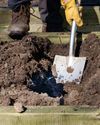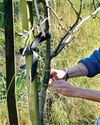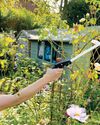
IF you want plants to grow you have to give them the right food, and the right conditions for them to make use of it. The acidity or alkalinity (pH) of garden soil affects the way food can be taken out of the soil by plants, but the essential nutrients – nitrogen, phosphorous and potassium (NPK) – must be there in the first place. So it’s important to know not just the pH, but also what’s missing so you can add more, and what’s already there so you don’t provide too much!
Simple testing kits that just determine soil pH are widely available. You can also buy more elaborate kits from garden centres and online to determine NPK, but for both types the starting point is a good soil sample.
How to take a sample
Take soil samples in dry weather when it hasn’t been raining for at least a couple of days. Don’t take samples if you have added lime or humus-rich material to the soil within three months.
From a garden flowerbed take three separate samples from different points across the bed. Cleanliness is essential. Wash, rinse, then dry your garden trowel and use it to scrape away the top 2in (5cm) of soil at each sampling point.
Diese Geschichte stammt aus der February 01, 2020-Ausgabe von Amateur Gardening.
Starten Sie Ihre 7-tägige kostenlose Testversion von Magzter GOLD, um auf Tausende kuratierte Premium-Storys sowie über 8.000 Zeitschriften und Zeitungen zuzugreifen.
Bereits Abonnent ? Anmelden
Diese Geschichte stammt aus der February 01, 2020-Ausgabe von Amateur Gardening.
Starten Sie Ihre 7-tägige kostenlose Testversion von Magzter GOLD, um auf Tausende kuratierte Premium-Storys sowie über 8.000 Zeitschriften und Zeitungen zuzugreifen.
Bereits Abonnent? Anmelden

To dig or not to dig?
Should we be carrying out a full dig on plots now? Bob considers the pros and cons of the 'autumn dig' debate

The box ball blues
As if his beleaguered box hadn't already taken a beating, Toby now has to deal with some hungry box caterpillars

Save your own seeds
Masterclass on: seed saving

Strange sightings
Three unusual insects turn up in Val's garden in one day

A bolt from the blue!
Cornflowers are perfect for garden and vase

Winter moth prevention
Ruth shows you how to avoid maggoty tree fruits

Create a winter container
There are as many options as in summer

Lightweight gardening tools
AS well as being good for our mental health, gardening is also great exercise.

Autumn price round-up
AG finds better bargains in lesser-known brands

Rudbeckias
Rudbeckias are ideal for sunny summer patios and borders, with some able to survive our coldest winters